Abstract
Purpose:
The most common chronic disease of childhood is early childhood caries which is five times more prevalent than asthma and seven times higher than that of allergic rhinitis. Most children do not receive dental care until they are three years old, yet by the time more than thirty percent of children from lower socioeconomic groups already have caries. To determine the prevalence and severity of early childhood caries among pre-school children, to describe the child characteristics associated with the development of early childhood caries and to find the association of early childhood caries and maternal risk factors.
Materials and Methods:
This descriptive study was carried out among children attending the immunization clinic of Sree Avittam Thirunal Hospital, Medical College, Trivandrum and children attending the randomly selected Anganwadies and Day care centres in Trivandrum, the capital of Kerala, wherein there are migrants from all over the State. A total of 350 children aged 12-36 months and their mothers were studied. The mother was first interviewed by a structured questionnaire; then the child's and mothers clinical examination was carried out covering caries experience and oral hygiene status.
Results:
Among 350 children studied the prevalence of dental caries in this study population was found to be 50.6 %(177). Statistically significant associations were found between the severity of decay and the child's age(P<0.001), female gender(P<0.05),low socioeconomic status (P<0.05), feeding frequency (P<0.05), type of feeding(P<0.01), fell asleep with nipple in mouth (P<0.05), duration of breast feeding(P<0.001), consumption of cariogenic type of snacks(P<0.01), age of commencement of tooth brushing(P<0.05), brushing frequency(P<0.05), oral hygiene status of child(P<0.001), DMFS scores of mothers (P<0.001), and oral hygiene status of mother (P<0.001).
Keywords: Early childhood caries, prevalence and severity, maternal risk factors
Introduction
Oral health is an essential component of total health and well-being, and it affects numerous aspects of a person's health status, quality of life, including self-esteem, learning, employment, ability to masticate and speak and other levels of routine activities. The most common chronic disease of childhood is early childhood caries (ECC). Quite often, the children do not receive dental care until they reach 3 years of age. By this time, more than 30% of the children from lower socioeconomic strata already get caries.[1]
Carious lesions are produced from the interaction of cariogenic microorganisms, fermentable carbohydrates, and teeth. Given the proper time, these factors induce incipient carious lesions that continue to progress. The major mechanism by which children acquire mutans streptococci is through the vertical transmission of infected saliva as a result of untreated caries from mother to child. The American Academy of Pediatric Dentistry (AAPD)[2] reported that infants and toddlers whose mothers have high levels of mutans streptococci are at a higher risk for acquiring the organism than the children whose mothers have lower levels.
Once the transmission of mutans streptococci occurs, the bacteria adhere to the surfaces of the child's teeth.[3] When combined with products that contain fermentable carbohydrates, the process of metabolism is initiated by the bacteria producing acidic end products that ultimately lead to the demineralization of tooth enamel, which in turn, contributes to dental caries. Inappropriate feeding practices by caregivers enhance the risk for the development of ECC in infants and toddlers.
Despite reports of an overall decrease in caries, severe decay is still a prevalent disease of early childhood. It is estimated that 8% of 2-year-old children have at least one decayed or filled tooth and that, by age 5, gets increased to 40% of the children. There are no previous research studies relating to the association of maternal risk factors and child characteristics with caries severity among the pre-school children in Kerala, and hence the present study was carried out.
Objectives
The objectives of the study were to determine the prevalence and severity of ECC among pre-school children and to describe the child characteristics associated with the development of ECC with a view to ascertaining the association of ECC and maternal risk factors. The study focused on the areas such as prevalence and severity of ECC, maternal risk factors and child characteristics associated with the development of ECC.
Materials and Methods
The present study was undertaken with a descriptive design during September 2008–June 2009. The population consisted of the children attending the immunization clinic of Sree Avittam Thirunal Hospital attached to the Medical College, Trivandrum, and children attending the Anganwadies and daycare centers in Trivandrum, the capital of Kerala, wherein the people from all the parts of the state migrate. Prior permission was obtained from the Institutional Ethical Committee of Trivandrum Dental College to carry out the study. Oral consent was obtained independently from the mothers of all children covered under the sample. A pilot study was conducted to pretest the method of examination and data collection forms.
A total of 350 children aged 12–36 months and their mothers were examined and interviewed for the study. The children with any systemic disease or any congenital syndromes or suffering from any skeletal and dental developmental disorders were excluded from the sample for the study.
Data collection
Tool and techniques
The study comprised two phases. In the first phase, data were generated using a structured interview schedule to assess the demographic characteristics such as children's age, sex, sibling rank, mother's level of education, socio economic status, maternal sharing of utensils, child's feeding habits, snacking habits, type of drinks in bottle feeding, child's oral hygiene habits, and mother's dental health knowledge. In the second phase, the children and their mothers were examined in their respective places by the same examiner. Type 3 clinical examination was carried out with the help of mouth mirror and explorer under good natural daylight as per World Health Organization (WHO) specification. Dental caries was diagnosed using visual and tactile method and caries was recorded according to WHO criteria.[4]
Child's caries experience was measured by defs scores and mother's caries experience was measured by DMFS scores. Oral hygiene status of each mother and her child was measured from debris scores of mother and child using the criteria of simplified oral hygiene index (Jhon C Greene and Jack R Vermillion, 1964) and a modification of the simplified oral hygiene index (Miglani DC, Beal JF, James PM and Behari SA et al., 1973), respectively.
Analysis of data
Data were analyzed using the computer software, Statistical Package for Social Sciences (SPSS) version 10. In order to elucidate the associations and comparisons between different parameters, chi-square (χ2) test was used as a nonparametric test. Multivariate Pearson's correlation analysis was employed to find out the relationship between various parameters. A logistic regression analysis was performed with caries (yes-no) as the dependent variable and other selected parameters as the independent variables. For the statistical evaluations, a two-tailed probability of value <0.05 was considered significant.
Results
Caries was evaluated by creating five ordinal groups based on the level of defs. First group was created with a score of 0; 49.4% of the total population was in this group. Children with a score of >0 were divided into quartiles resulting in the following groups: a) 1–4; b) 5–11; c) 12–21; and d) 22–46 defs.
Out of the 350 children studied, 49.4% were caries free and 50.6% were affected by caries [Figure 1]. Of the 177 children affected by caries, 20.6% children presented with a defs score between 1 and 4; 16% children presented a score between 5 and 11; 7.7% children had a score between 12 and 21; and 6.3% children a score between 22 and 46.
Figure 1.
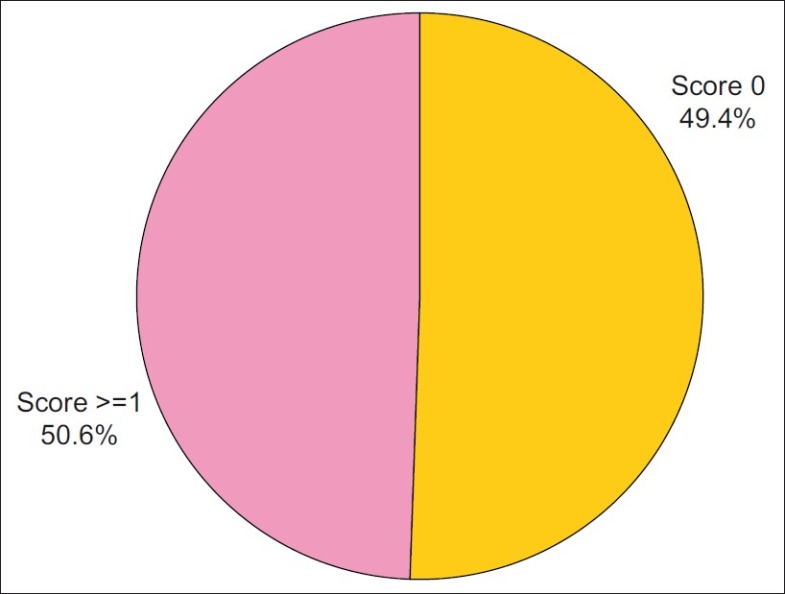
Caries prevalence
Distribution of children according to the age is shown in Table 1. Analysis using chi-square test showed a statistically significant positive association between age and severity of decay (P < 0.001) as depicted in Figure 2. Of the 350 children studied, sex-wise distribution between male and female was 51.1% to 48.9%. The caries severity was found to be more prevalent among female children and the difference was statistically significant (P < 0.05) as shown in Table 2. The results indicated a significant inverse relationship between the socioeconomic status of the children and dental caries severity (P < 0.05).
Table 1.
Distribution of children according to age
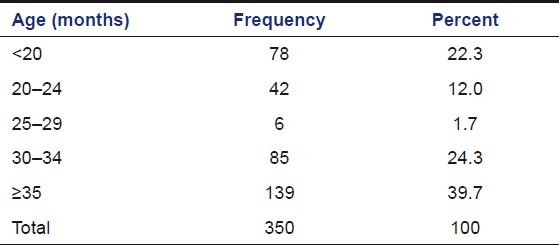
Figure 2.
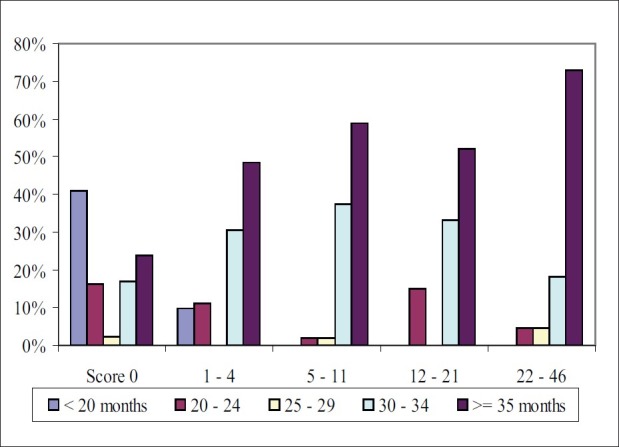
Association between age and severity of decay
Table 2.
Association between sex and severity of decay
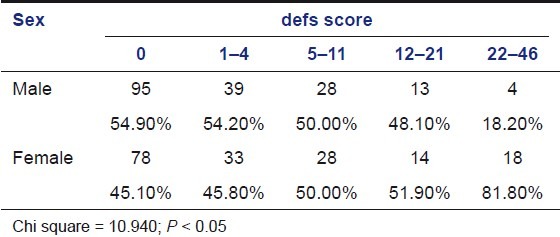
Distribution of children examined based on their order of birth showed that 51.4% were first born, 42.9% were second born and 5.7% were third born children of the mothers covered under the study. Caries severity was found to be less in the second born children than in the first born children. However, the difference in this phenomenon was not found to be statistically significant (P > 0.05).
Table 3 shows the distribution of mothers according to their age. This analysis shows that as maternal age decreases, the severity of decay in children increases. But this difference remained statistically significant (P > 0.05). Of the 350 mothers who were interviewed, 63.4% were school educated, 34% graduated and 2.6% post graduated. The severity of decay was higher among the children of school educated mothers than the children of graduated and post graduated mothers. But this observation was not found to be statistically significant (P > 0.05).
Table 3.
Distribution of mothers according to age

Distribution of children according to their feeding frequency is presented in Table 4. The association between caries severity and feeding frequency was found to be statistically significant, with higher severity occurring among the children having a feeding frequency of >10 times/day (P < 0.05).
Table 4.
Distribution of children according to their feeding frequency

Caries severity in relation to type of feeding is shown in Table 5. The method of feeding showed a statistically significant association with the caries severity, depicting higher severity occurring among the children who were fed with combined methods (P < 0.01). The relation of type of drinks in bottle feeding with caries experience was also evaluated. There was no positive relationship between the type of drinks in bottle feeding and the severity of decay (P > 0.05).
Table 5.
Association between type of feeding and severity of decay

Table 6 reveals the frequency distribution of children according to some dietary practices. Among 350 children studied, 88.6% fell asleep with nipple in their mouth. The association between children who fell asleep with nipple in their mouth and caries severity was found to be statistically significant (P < 0.05). The pacifier use was limited to a very few children in the population. Only 5.1% had used a pacifier, making clear the relationship between pacifier use and caries severity statistically insignificant (P > 0.05). Among the children who were examined, 98.3% had the habit of between meal snacking. Of this, 56.7% children consumed cariogenic type of snacks and 43.3% less cariogenic type of snacks. Caries severity was more prevalent among the children who took cariogenic type of snacks and the association between the variables was highly significant (P < 0.01).
Table 6.
Distribution of children according to some dietary practices
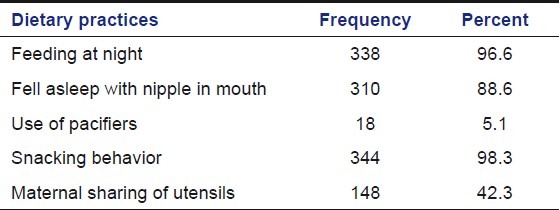
Of the 350 mothers interviewed, 42.3% revealed that they put spoon into the mouth of their children at the time of feeding. The relationship between maternal sharing of utensils and severity of decay was not found to be statistically significant (P > 0.05).
Table 7 shows the distribution of children according to their duration of breastfeeding. The results indicated a significant association between caries severity and duration of breastfeeding (P ≤ 0.001), as shown in Figure 3.
Table 7.
Distribution of children according to their duration of breastfeeding
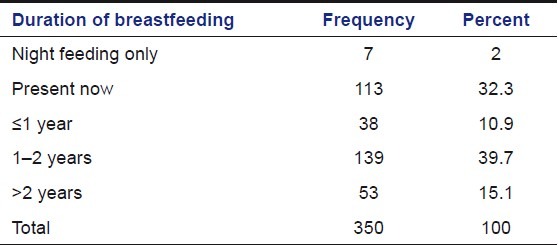
Figure 3.

Association between duration of breastfeeding and severity of decay
In the present study, no correlation was found between the time of first primary tooth eruption and severity of decay (P ≥ 0.05). The primary caregivers were mothers in 96.3%, caretakers in 0.9% and grandmothers in 2.9% children examined for the study. The association between child's primary care giver and caries severity was not found to be statistically significant (P ≥ 0.05).
Of the 350 children examined, 319 had the habit of tooth brushing. Of these, for 40.8% children, the habit of tooth brushing was started before the completion 1 year of age, for 58.3% between 1 and 2 years and for 0.9% after 2 years. The results showed a higher severity of decay among the children who started tooth brushing after 1 year of age. The association between the age of commencement of tooth brushing and caries severity was found to be statistically significant (χ2 = 19.802; P < 0.05).
Among the 350 children studied, it was made known that 78.6% children had a brushing frequency of once daily, 12.3% brushed twice daily, and 0.3% brushed thrice daily, whereas 8.9% never brushed their teeth. The severity of dental caries was less among the children who brushed their teeth twice daily than among the children who brushed their teeth once daily. The association between the brushing frequency and severity of decay was found to be statistically significant (P < 0.05).
Only 29.7% of the mothers were aware of the harmful effect of keeping bottle in child's mouth during sleep, although 32.6% mothers were aware of the importance of primary teeth. Caries severity was higher among children whose mothers were not aware of the harmful effect of keeping bottle in the child's mouth during sleep, and among the children whose mothers were not aware of the importance of the primary teeth. However, the differences were not found to be statistically significant (P > 0.05).
Table 8 shows the frequency distribution of children and mothers according to their oral hygiene status. The results revealed a higher severity of decay in children with fair or poor oral hygiene than in children with good oral hygiene. This difference was found to be statistically highly significant (P < 0.001). It was noted that the severity of ECC was higher among the children whose mothers had fair or/poor oral hygiene status than among the children whose mothers had good oral hygiene status. This difference was found to be statistically highly significant (χ2 = 43.921; P < 0.001).
Table 8.
Frequency distribution of children and mothers according to their oral hygiene status
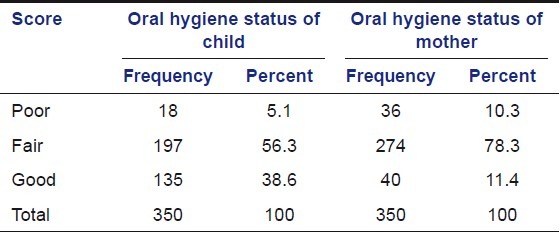
Table 9 shows the distribution of the mothers covered under the current study according to their DMFS scores. The association between DMFS score and caries severity among the children was found to be statistically significant (P < 0.001), as depicted in Figure 4.
Table 9.
Distribution of mothers according to their DMFS scores
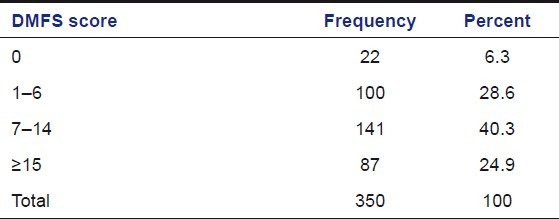
Figure 4.
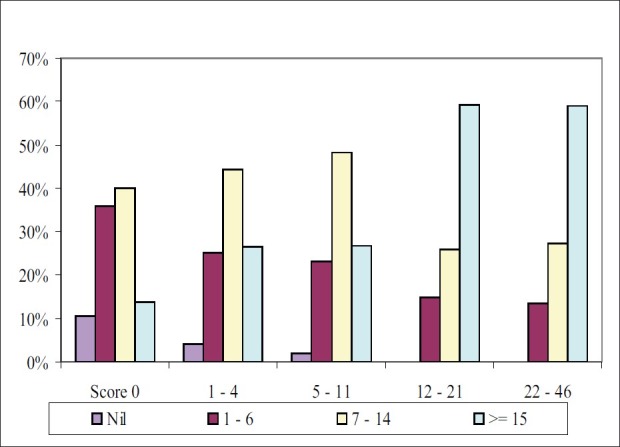
Association between caries severity in mother and severity of decay in children
Table 10 shows the correlation of child's caries severity with the selected parameters used for the study. In the logistic regression analysis, the child's age (OR = 9.367), type of feeding (OR = 2.208), feeding at night (OR = 5.181), feeding frequency (OR = 1.712), falling asleep with nipple in the mouth (OR = 2.923), use of pacifiers (OR = 3.763), snacking behavior (OR = 2.024), maternal sharing of utensils (OR = 1.558), oral hygiene status of the child (OR = 10.298), oral hygiene status of the mother (OR = 1.912) and DMFS of the mother (OR = 4.842) were found to be important risk factors on a child's caries development.
Table 10.
Correlation of child's caries severity with selected parameters
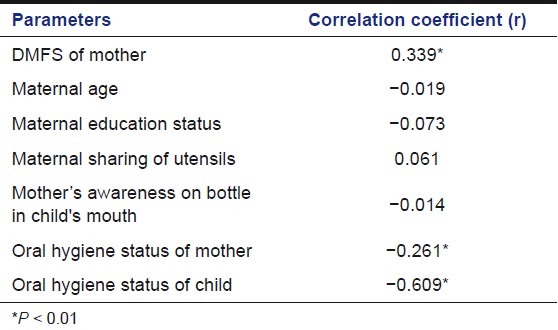
Discussion
Nursing caries has received little attention from the health professionals other than pediatric dentists. The dental health of pre-school children in whom nursing caries is evident has largely been ignored. The reason for this is that the primary teeth are not considered as important as the permanent teeth.[5] Besides, this population is relatively inaccessible because the disease occurs at such a young age, and it is very difficult to record the prevalence of the problem on a true population basis. The prevalence of dental caries in the present study was 50.6% which was slightly higher than that reported by Jose and King[6] who reported a caries prevalence of 44% among the pre-school children aged from 8 to 48 months in Kerala.
The increased caries experience with age, found in the present study, has been observed in many countries.[7] In the logistic regression analysis, the child's age was found to be an important risk factor for a child's caries development (OR = 9.367). This indicates that educational programs intended to prevent caries on deciduous teeth should begin in the first year of life among children before the condition becomes too advanced to prevent, with a view to avoid the difficulties and huge expenses.
In the present study, the caries severity was more in female children and the difference was found to be statistically significant (P < 0.05). This observation was previously reported in a study of children aged 12–36 months in the city of Recife, Brazil, by Rosenblatt and Zarzar.[8] The greater risk for development of caries among girls may be partly on account of the earlier growth and development.[9] Caries experience and socioeconomic background have repeatedly been reported to be negatively related to each other.[6,10] In the current study too, a significant negative association (P < 0.05), was found between the socioeconomic status of the children, as measured by income, and dental caries severity. This may also be due to the high social status inclusive of cent percent literacy prevailing in Kerala state irrespective of the economic status.
In the current study, a negative but not statistically significant correlation (r = –0.019) was found between maternal age and severity of decay in children. This corroborates with the findings of the study of Hallet and O’Rourke.[11] The Pearson's correlation analysis revealed an inverse relationship between maternal educational status and caries severity of children (r = –0.073). A few earlier studies regarding the level of education of the mothers and caries prevalence of children have shown lack of education of the mothers to be statistically related to their children's caries experience.[7,12]
The severity of decay was found to be higher among the children who showed increased frequency of feeding than among the children who had low frequency of feeding. In the present study, a statistically significant association was found between the method of feeding and caries severity, with higher severity occurring among the children who were fed using both (breast/bottle) methods (P < 0.01; OR = 2.208). The severity of decay was found to be higher among the children who fell asleep with nipple in their mouth than in those without (P < 0.05, OR = 2.923). The children who are fed at night have 5.1 times risk for developing caries compared to the children who are not fed at night. In this study, the severity of dental caries was found to be more among children who were breastfed for more than 12 months. This finding is in agreement with the observation made in the earlier studies.[13]
The age at which oral hygiene measures are commenced is of importance in establishing and maintaining the oral health of children. It is generally recommended to commence the tooth brushing as soon as the first tooth erupts. In the present study, the severity of decay was found to be higher among the children in whom tooth brushing was started after 24 months of age and the severity of dental caries was found to be lesser among the children who were brushed twice daily than among the children in whom brushing was done once daily. These findings are in conformity with the results of studies conducted by Mazhari et al.[10]
Poor oral hygiene is widely considered as a caries risk factor. The correlation between oral hygiene of a child and severity of decay was found to be negative in Pearson's analysis (r = –0.609, P < 0.01). In logistic regression analysis, it was found that children with poor oral hygiene had elevated risk for nursing caries, the odds ratio being 10.29. The results of the present study identify well with the findings of the research conducted by Retnakumari in Kerala.[14]
The oral health factors of mothers, such as high caries experience and poor oral hygiene, could be important risk indicators for caries in their children.[15] In the current study, a positive correlation was found between dmfs0 scores of mothers and caries severity among their children (r = 0.339; P < 0.01). This is in agreement with the results of a study conducted by Ersin et al.[16] on 15–35-month-old Turkish children and their mothers. In logistic regression analysis, it was found that the children of mothers with decayed teeth had 4.8 times increased chances of developing dental caries.
Adoption of consistent behavioral habits in the childhood takes place at home, with the parents, especially the mothers, being the primary model for behavior.[17] In the present study, a statistically significant association was found between mothers’ oral hygiene status and severity of decay among the children (P < 0.001; OR = 1.912). In Pearson's analysis, an inverse relationship was found between the oral hygiene status of mother and the severity of decay among the children (r = –0.261, P < 0.01). Results of the current study suggest that if mothers could be encouraged to take good care of their own teeth, it may induce better oral health behavior and dental condition in their children.
Conclusions
The maternal factors, such as high DMFS scores, poor oral hygiene status and low socioeconomic factors, were the strong risk indicators for identifying children susceptible to caries. Child's feeding habits such as feeding frequency, type of feeding, falling asleep with nipple in the mouth, feeding at night, in between meal snacking and duration of breast feeding have significant direct relationship with the severity of ECC. Severity of ECC was found to be significantly related to the children's frequency of tooth brushing and the oral hygiene status.
Footnotes
Source of Support: Nil.
Conflict of Interest: None declared.
References
- 1.Douglass JM, Douglass AB, Silk HJ. A practical guide to infant oral health. Am Fam Physician. 2004;70:2113–20. [PubMed] [Google Scholar]
- 2.American Academy of Pediatric Dentistry. Policy on early childhood caries: Classifications, consequences, and preventive strategies. Paediatr Dent Reference Manual. 2007;29:39–41. [Google Scholar]
- 3.Slavkin HC. Streptococcus mutans, early childhood caries and new opportunities. J Am Dent Assoc. 1999;130:1787–92. doi: 10.14219/jada.archive.1999.0138. [DOI] [PubMed] [Google Scholar]
- 4.Oral health surveys: Basic methods. Geneva, Switzerland: WHO; 1997. World Health Organization. [Google Scholar]
- 5.Blinkhorn AS. The caries experience and dietary habits of Edinburgh nursery school children. Br Dent J. 1982;152:227–30. doi: 10.1038/sj.bdj.4804790. [DOI] [PubMed] [Google Scholar]
- 6.Jose B, King NM. Early childhood caries lesions in preschool children in Kerala, India. Paediatr Dent. 2003;25:594–600. [PubMed] [Google Scholar]
- 7.Kiwanuka SN, Astrom AN, Trovik TA. Dental caries and its relationship to social and behavioral factors among 3-5-year old children in Uganda. Int J Paediatr Dent. 2004;14:336–46. doi: 10.1111/j.1365-263X.2004.00570.x. [DOI] [PubMed] [Google Scholar]
- 8.Rosenblatt A, Zarzar P. Breast feeding and early childhood caries: An assessment among Brazilian infants. Int J Paediatr Dent. 2004;14:439–45. doi: 10.1111/j.1365-263X.2004.00569.x. [DOI] [PubMed] [Google Scholar]
- 9.Tapias MA, Miguel G, Jimen GR, Gonzalez A, Dominguez V. Incidence of caries in an infant population in Mostoles, Madrid: Evaluation of a preventive program after 7.5 years of follow-up. Int J Paediatr Dent. 2001;11:440–6. doi: 10.1046/j.0960-7439.2001.00307.x. [DOI] [PubMed] [Google Scholar]
- 10.Mazhari F, Talebi M, Zoghi M. Prevalence of early childhood caries and its risk factors in 6-60 months old children in Quchan. Dent Res J. 2007;4:96–101. [Google Scholar]
- 11.Hallet KB, O’Rourke PK. Social and behavioral determinants of early childhood caries. Aust Dent J. 2003;48:27–30. doi: 10.1111/j.1834-7819.2003.tb00005.x. [DOI] [PubMed] [Google Scholar]
- 12.Ferreira SH, Beria JU, Kramer PL, Feldens EG, Feldens CA. Dental caries in 0-to 5-year old Brazilian children: Prevalence, severity and associated factors. Int J Paediatr Dent. 2007;17:289–96. doi: 10.1111/j.1365-263X.2007.00831.x. [DOI] [PubMed] [Google Scholar]
- 13.Al-HSussyne A, Al-Sadan SA. Feeding practices and behavior of Saudi children with early childhood caries and dental knowledge of their mothers. Saudi Dent J. 2002;14:112–7. [Google Scholar]
- 14.Retnakumari N. Prevalence of dental caries and risk assessment among primary school children of 6-12 years in the Varkala municipal area of Kerala. J Indian Soc Pedo Prev Dent. 1999;17:135–42. [PubMed] [Google Scholar]
- 15.Thorild I, Lindau-Jonson B, Twetman S. Prevalence of salivary Streptococcus mutans in mothers and their preschool children. Int J Paediatr Dent. 2002;12:2–7. [PubMed] [Google Scholar]
- 16.Ersin NK, Eronat N, Coglu D, Uzel A, Aksit S. Association of maternal-child characteristics as a factor in early childhood caries and salivary bacterial counts. J Dent Child. 2006;73:105–11. [PubMed] [Google Scholar]
- 17.Tiberia MJ, Milnes AR, Feigal RJ, Morey KJ, Richardson DS, Croft WG, et al. Risk factors for early childhood caries in Canadian preschool children seeking care. Pediatr Dent. 2007;27:201–8. [PubMed] [Google Scholar]


